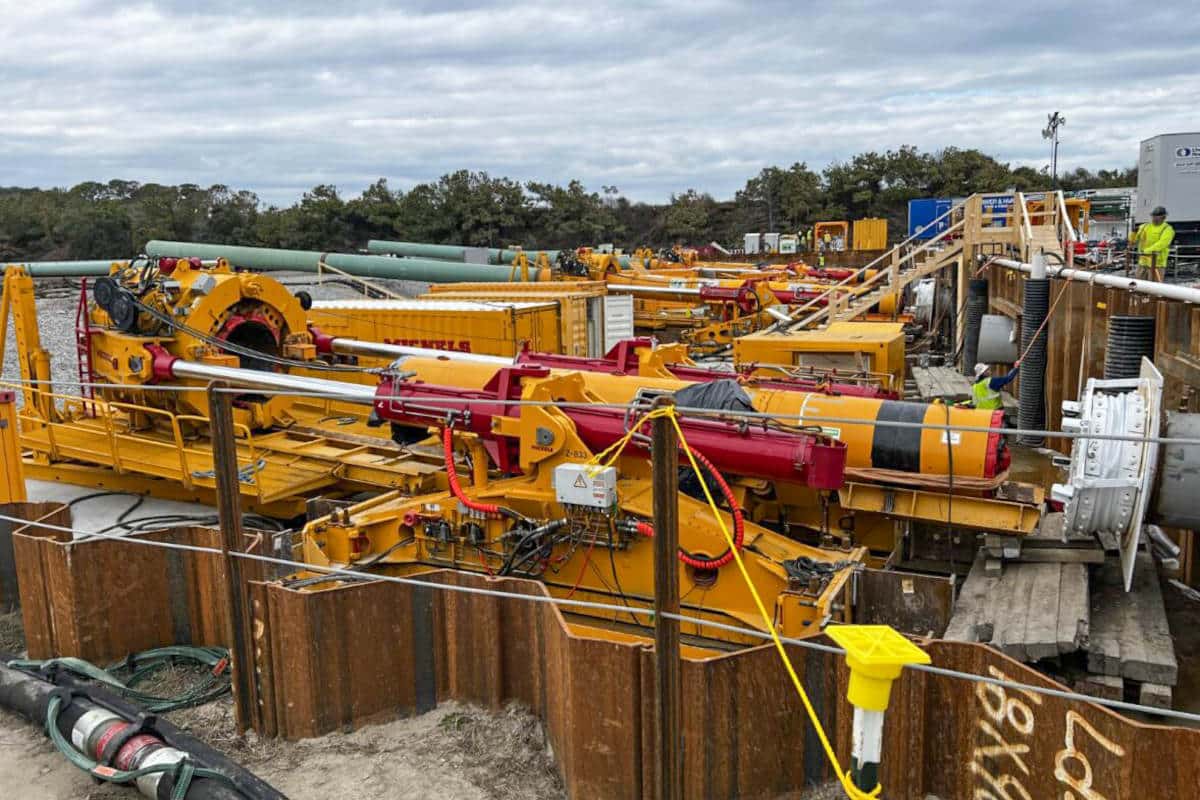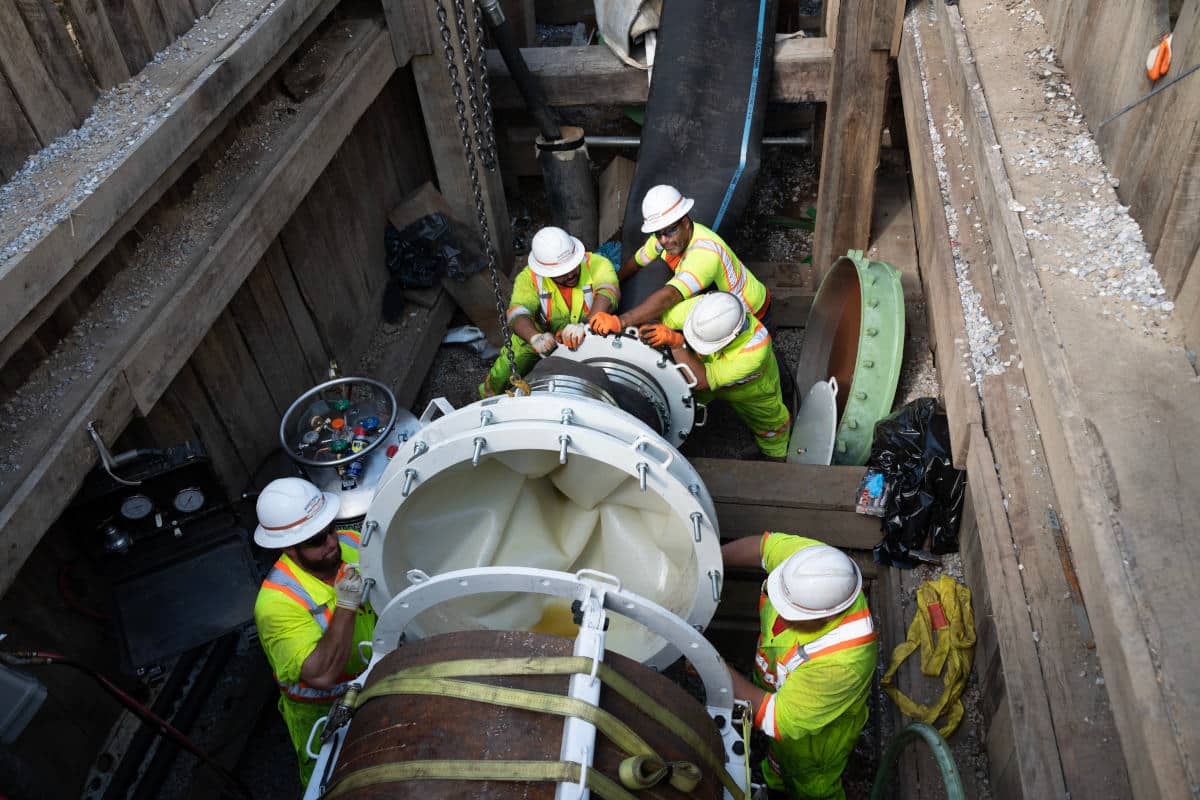2012 Project of the Year Rehab Runner Up: Pipeline Condition Assessment
October 11, 2012
 The City of Raymore, Mo., and PICA USA conducted an inspection of a 24-in. wastewater force main in December 2011. The purpose of this project was to measure the remaining wall thickness of the pipe so that the city could improve its asset management.
The City of Raymore, Mo., and PICA USA conducted an inspection of a 24-in. wastewater force main in December 2011. The purpose of this project was to measure the remaining wall thickness of the pipe so that the city could improve its asset management. PICA’s patented SeeSnake tool was used to accomplish this feat. The 17,500-ft pipeline is ductile iron with a cement mortar lining and pumps an average of 750,000 g/d, operating at 80 to 100 psi. It was installed in the early 1990s, with a pump station upgrade in 2007. This force main was selected for inspection because of its importance to the city infrastructure and three previous breaks in the preceding two years. The project required gaining access to the interior of the pipe near a pump station, inserting PICA’s 14-ft inspection tool, propelling the tool with flow and receiving it five miles away at a manhole. The construction work was performed by Redford Construction and involved:
A) excavating the existing pipe and installing a large launch tube and
B) making modifications to the receive manhole.
The City of Raymore operated pumps, cleaned the pipeline with foam pigs and provided general assistance. PICA was responsible for launching the inspection tool, tracking its location and providing a report on the pipeline’s condition. After Raymore personnel cleaned the pipeline using different density foam swabs provided by Pipeline Pigging Products, PICA technicians mobilized to the job location in December. The inspection tool requires a speed of around 15 ft/second, resulting in an inspection time of about 19 hours.
The City had two large capacity ponds that afforded the pipeline to be taken out of service during the inspection. (The pipeline was full of effluent, but the pumps were not running). The tool was loaded into the pipeline at dusk and propelled using a 400-gpm jockey pump. It traveled effortlessly until the first of three 90-degree bends. At this location, additional pressure was applied to propel the tool around the bend and then it continued on its way. This procedure was repeated for the remaining 90 degree bends. The tool arrived at the receiving manhole the following day and was removed using a backhoe. The data was downloaded and analyzed for the City to incorporate into their asset management plan. The initial contract with the City called for analysis of the first 5,000 ft with the option to analyze the rest at a future date. Of the initial 5,000 ft inspected, two-thirds were in relatively poor condition. This was due to highly corrosive soil that was tested by a third party. Currently, the City is making plans for PVC replacement of some of this pipe.
The remaining third of the pipe was in more serviceable condition and will be left in-situ for the time being. The remaining 12,000 ft of analysis involves pipe in residential settings and is likely to be completed this next year.
What Makes This Project Outstanding
 Asset managers are tasked with extending their infrastructure to its longest serviceable timeline. With regard to pipelines, this job is made difficult by the fact that the asset is buried with limited accessibility. In the past, engineers have used a variety of tools to best understand their infrastructure, including: soil samples, visual external monitoring, CCTV, breaks history and relative age of the pipe. The limits of these techniques have resulted in a mostly reactive approach to pipeline maintenance not because asset managers lacked the desire to be proactive but because the inspection industry had yet to develop the tools. The Raymore, Mo., inspection demonstrates that these proactive tools are now becoming available in the marketplace. The high-quality analysis available to Raymore allow for improved asset management. The PICA tool measured the remaining thickness of the pipe wall. Much of the pipe wall was in 100 percent condition; in fact, the average wall thickness registered as 89 percent of its original condition (meaning the pipe had corroded, on average, 11 percent). This 11 percent was not distributed evenly across the entire pipe, so some sections experienced higher levels of corrosion.
Asset managers are tasked with extending their infrastructure to its longest serviceable timeline. With regard to pipelines, this job is made difficult by the fact that the asset is buried with limited accessibility. In the past, engineers have used a variety of tools to best understand their infrastructure, including: soil samples, visual external monitoring, CCTV, breaks history and relative age of the pipe. The limits of these techniques have resulted in a mostly reactive approach to pipeline maintenance not because asset managers lacked the desire to be proactive but because the inspection industry had yet to develop the tools. The Raymore, Mo., inspection demonstrates that these proactive tools are now becoming available in the marketplace. The high-quality analysis available to Raymore allow for improved asset management. The PICA tool measured the remaining thickness of the pipe wall. Much of the pipe wall was in 100 percent condition; in fact, the average wall thickness registered as 89 percent of its original condition (meaning the pipe had corroded, on average, 11 percent). This 11 percent was not distributed evenly across the entire pipe, so some sections experienced higher levels of corrosion. PICA’s analysis was able to pinpoint these locations and Raymore was able to act accordingly. This new level of knowledge truly is an industry changer, PICA officials say. Other important technical “wow” factors include the sensitive internal condition of the cement mortar liner. When performing this inspection, it was important not to damage the internal liner and create new problems while trying to diagnose old ones. This required a non-contact, non-abrasive tool. PICA’s tool was designed to safely navigate the internal environment of the pipeline while maximizing data quality. In addition to the fragile liner, navigating a 90-degree bend with a 14-ft tool is no small task.
The mechanical design of the 24-in. tool proved to the industry that tight bends are no longer a hurdle for in-line inspections.
Project Owner: City of Raymore, Mo.
Engineer: Phil Becker
Contractor: PICA USA, Redford Construction




